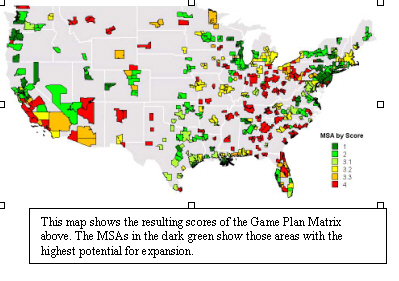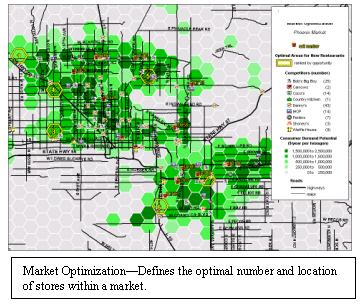An operator and franchisor of more than three hundred mid-scale family dining restaurants came to Claritas looking to expand their concept. They were faced with several real estate challenges, ranging from determining which markets to enter to identifying those sites to build on.
Recognizing that brand awareness was key to success, they wished to focus their attention on markets in which they could be the dominant player. Their location strategy within these markets was to open as many units as the market could support. This saturation was critical, but posed inherent risks. Cannibalization between units would not only hurt sales performance, but because many units are franchised, could potentially result in other corporate issues.
Claritas implemented a three-stage research program:
1. Prioritize markets for
expansion
Claritas developed a market-screening
model to score all U.S. metropolitan areas. Scoring was based on
the market’s demand potential and the potential share of the demand they
could expect to capture. Claritas’ MicroVision segmentation system
provided the crucial data needed for such scoring.
First, a MicroVision profile of mid-scale
family diners was created. This profile showed the propensity of
each segment to visit this type of restaurant, as well as their spending
levels. The profile was then statistically compared to the profile
of consumers in each market to systematically measure the fit between market
consumers and the restaurant concept. Using Claritas’ Business-Facts and
other databases, an inventory of competitors in each market was compiled.
Next, through the combination of the profile and competitive data, the
chain’s share potential of the market was measured. A game plan matrix
was constructed which rated markets in terms of both demand and share potential.
The game plan matrix helps the restaurant
chain understand the gap that might exist between total market demand and
that which is served by competitors. This makes it possible to determine
where the demand and share potentials are, so that the new restaurant concept
could likely assume the position of the dominant family dining restaurant
chain in a large market.
2. Optimize the restaurant
network in expansion markets
The client was also faced with the
problem of determining the number of new units to open in each market and
where the new restaurants should be developed. Several considerations
had to be factored into such an analysis:
- Where did potential customers live, work, and shop?
- Who were the competitors, what were their strengths, and where were they located?
- How would network expansion affect the performance of existing units?
Based on these considerations,
Claritas developed a market optimization model that was used to determine
the best arrangement of restaurants within a market. The model simultaneously
determines how many units a market can support and where. The model considered
demand levels for the new concept, activity levels in areas, competitive
influences, and potential impacts upon their existing units to identify
those general areas that could support a new restaurant.
3. Provide a tool to evaluate
the potential of specific restaurant sites.
To aid in the evaluation of each
location, Claritas developed a site potential model that could be used
to estimate the concept sales at a specific site. Through examination
of existing store performance, the model was statistically constructed
to relate a number of store and market specific variables to sales volumes.
The model allows the client to generate an unbiased assessment of the sales
that could be achieved at a site. This data isthen considered along
with the judgment of real estate personnel.
RESULTS
The restaurant chain has used the
results of the market screening, together with other considerations concerning
market location and marketing issues, to identify those markets it will
expand into or increase its presence. This information has also been
used to determine how these markets will be divided between corporate and
franchise operations.
The market optimization results have also been used to further analyze those markets scored highly in the market screening. The treatment of location factors in the optimization model has allowed the client to examine in detail the potential of each market. Now, armed with maps showing the market optimization results, real estate personnel are able to proceed to those areas identified for new restaurants in search of specific sites.
When presented with a large number of potential sites, the site potential model allows the client to quickly screen out those locations worth further inquiry. Additionally, while real estate personnel ultimately decide the fate of a site, the model allows their subjective judgment to be tempered against statistical evidence to assist in making the final decision. The model has also allowed the chain to establish performance benchmarks for their new and existing restaurants.
*This case study is based upon
an actual client whose name has been omitted to protect client confidentiality.